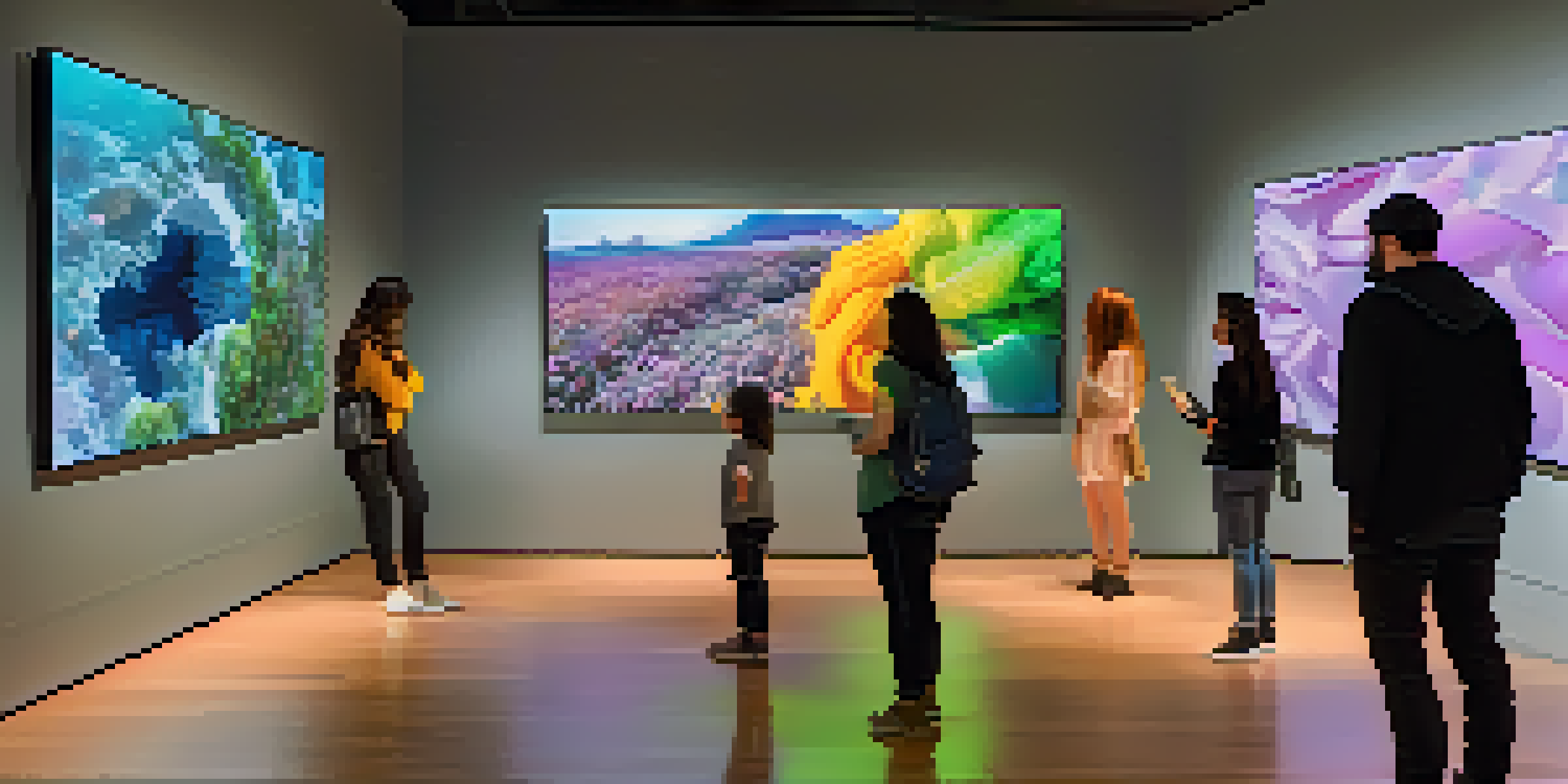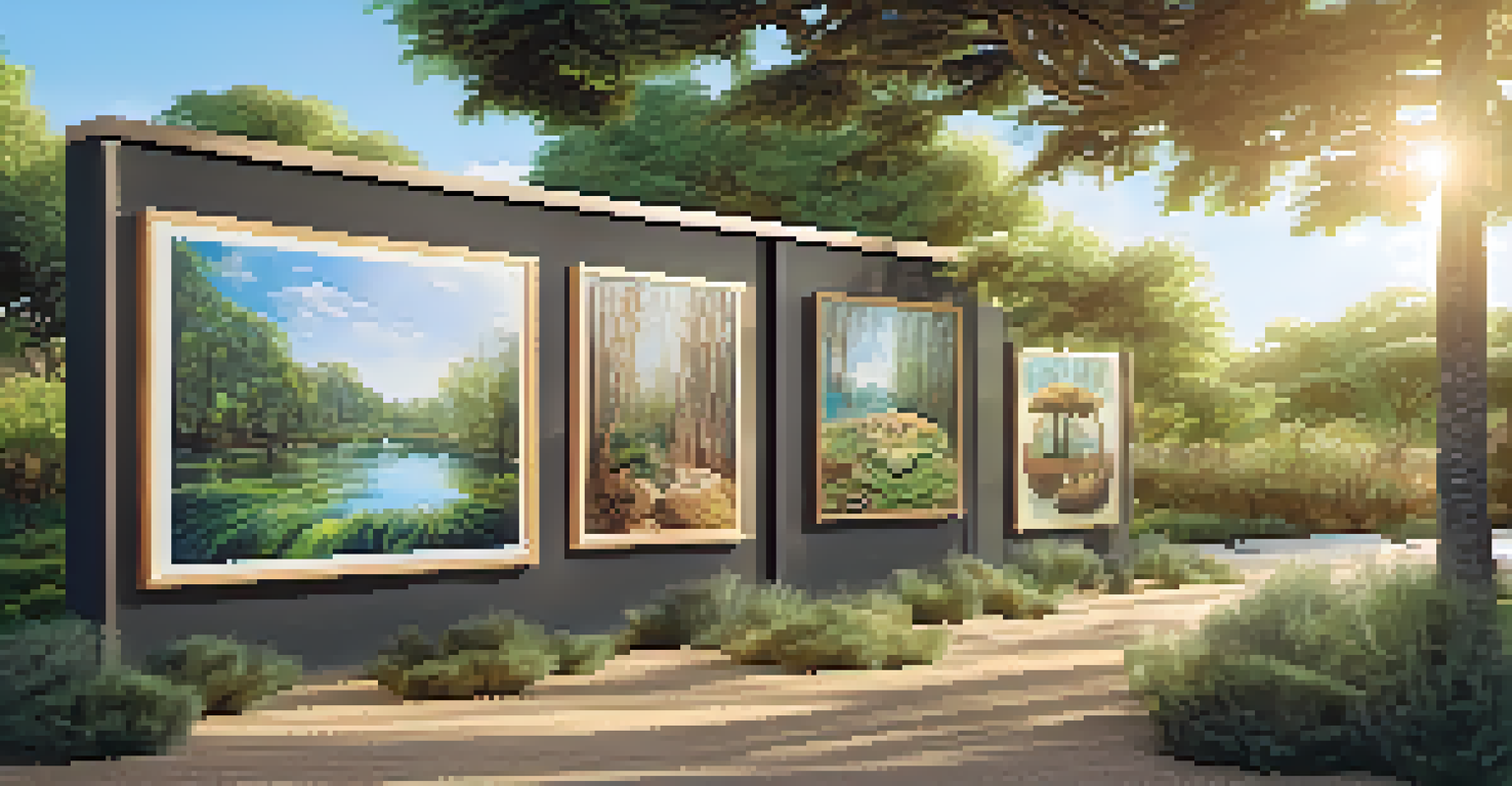Art Curation: Trends Influencing Global Exhibitions Today

The Rise of Virtual Exhibitions in Art Curation
In recent years, virtual exhibitions have taken the art world by storm. They allow curators to reach a global audience without the constraints of physical space. With advancements in technology, virtual galleries can now offer immersive experiences that rival traditional exhibitions.
Art is not what you see, but what you make others see.
This shift was particularly accelerated by the COVID-19 pandemic, which forced many institutions to adapt quickly. Artists and curators embraced platforms like Instagram and dedicated websites to showcase their work. As a result, virtual exhibitions are becoming a staple in the art world, providing accessibility and democratizing art appreciation.
Moreover, virtual exhibitions often come with interactive elements, such as guided tours and artist talks, making the experience more engaging. This trend not only widens the audience but also encourages dialogue and connection among art lovers from diverse backgrounds.
Sustainability: A Key Focus in Art Exhibitions
Sustainability has emerged as a vital principle in art curation today. As awareness of climate change grows, curators are increasingly mindful of their environmental impact. This includes everything from the materials used in exhibits to the logistics of transportation.

Many exhibitions now prioritize eco-friendly practices, such as using recycled materials and minimizing waste. For instance, some artists create works specifically designed to be biodegradable or made from sustainable sources. This conscientious approach not only enhances the narrative of the artwork but also resonates with audiences who value environmental stewardship.
Virtual Exhibitions Transform Art
Virtual exhibitions are reshaping the art world by providing greater accessibility and immersive experiences for global audiences.
Furthermore, sustainability in art curation often encourages collaboration with local communities, fostering a sense of collective responsibility. By integrating local culture and practices, exhibitions can offer a more meaningful experience while promoting environmental awareness.
Diversity and Inclusion in Art Curation
Diversity and inclusion are at the forefront of contemporary art curation. Curators are increasingly recognizing the importance of representing artists from various backgrounds, including underrepresented groups. This push for inclusivity enriches the cultural narrative and brings fresh perspectives to the art world.
Creativity takes courage.
Exhibitions that celebrate diversity often feature works that challenge traditional norms and provoke thought. By showcasing artists from different ethnicities, genders, and social backgrounds, curators can foster a more holistic understanding of art's role in society. This trend not only highlights marginalized voices but also encourages dialogue around important social issues.
Moreover, inclusive curation practices can enhance audience engagement. When diverse stories are told, more people can see themselves reflected in the art, leading to deeper connections and a broader appreciation for creativity.
Technology’s Impact on Art Curation Practices
Technology is revolutionizing the way art is curated and experienced. From augmented reality (AR) to artificial intelligence (AI), these innovations are reshaping the exhibition landscape. Curators are now leveraging technology to enhance storytelling and engage visitors in new ways.
For example, AR can bring static artworks to life, allowing viewers to interact with them in a more dynamic manner. This not only makes exhibitions more captivating but also encourages visitors to explore the narratives behind the art. Additionally, AI tools can help curators analyze data to better understand audience preferences and tailor exhibitions accordingly.
Sustainability Shapes Art Practices
Curators are increasingly prioritizing sustainability in art exhibitions by using eco-friendly materials and fostering local community involvement.
As technology continues to evolve, it is likely that we will see even more creative applications in art curation. This synergy between art and tech opens up exciting possibilities for enhancing visitor experiences and expanding the reach of exhibitions.
Experiential Curating: Engaging Audiences in New Ways
Experiential curating focuses on creating immersive experiences for audiences rather than just presenting artworks. This trend recognizes that viewers are seeking more than just visual stimulation; they want to feel a connection to the art. Curators are responding by designing environments that engage multiple senses.
For instance, some exhibitions incorporate soundscapes, tactile elements, and even scents to evoke emotions and enhance storytelling. This multi-sensory approach invites visitors to engage with art on a deeper level, transforming the viewing experience into an interactive journey. It also encourages active participation, making the exhibition memorable.
By prioritizing experiential elements, curators invite audiences to not just observe but to reflect and interact. This shift creates a shared space for dialogue and exploration, ultimately leading to a more profound appreciation of the artwork.
The Role of Social Media in Art Curation Today
Social media has become a powerful tool for art curation, enabling curators to connect with audiences in real-time. Platforms like Instagram and TikTok allow curators to showcase artwork, share behind-the-scenes insights, and engage with followers directly. This level of accessibility has transformed the way art is consumed and appreciated.
Curators are leveraging these platforms not only to promote exhibitions but also to foster community engagement. By sharing stories and insights about artists and their works, they create a sense of connection that transcends geographical boundaries. This democratization of art allows for diverse voices and interpretations to flourish.
Diversity Enhances Art Engagement
Emphasizing diversity and inclusion in art curation enriches cultural narratives and fosters deeper connections with a broader audience.
Additionally, social media enables curators to gather immediate feedback and insights from their audience. This interaction can inform future exhibitions and practices, making the curation process more dynamic and responsive to audience needs.
Global Collaborations: Bridging Cultures Through Art
Global collaborations are becoming increasingly common in art curation, bridging cultural divides and fostering international dialogue. Curators are partnering with artists and institutions from various countries to create exhibitions that reflect a shared human experience. This collaborative spirit enriches the narrative of the art and broadens its context.
These partnerships often result in exhibitions that highlight cultural exchange, allowing audiences to explore different perspectives and traditions. For example, a collaboration between curators from different countries might focus on themes like migration or identity, presenting artworks that speak to these universal experiences.

Moreover, global collaborations can enhance resource sharing and knowledge exchange among curators and artists. By working together, they can create more impactful exhibitions that resonate with diverse audiences, ultimately fostering a deeper understanding of global art practices.